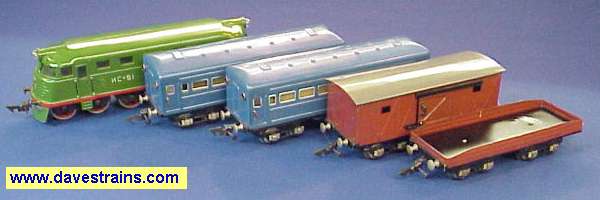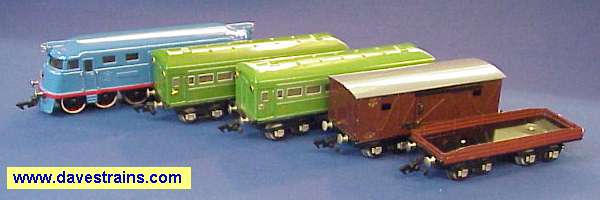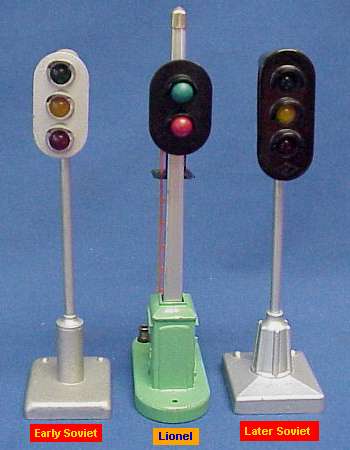www.davestrains.com
Phone: 732-271-5124 *** Fax: 732-271-9285 *** E-mail Dave & Joan
 Frequently Asked Questions & Glossary
Frequently Asked Questions & Glossary 
| This Web Page Last Updated: September 12, 2005 |
|---|

| Home | Site Map | Postwar Lionel | Soviet Trains | Place Order | Contact Us |
Phone: 732-271-5124 *** Fax: 732-271-9285 *** E-mail Dave & Joan
 Frequently Asked Questions & Glossary
Frequently Asked Questions & Glossary 
| This Web Page Last Updated: September 12, 2005 |
|---|

This page was developed to help our visitors learn about the trains that were produced during the 1950s and 1960s that have come to be known as "Stalin-era train sets" and "Khrushchev-era train sets" and to address questions that may arise. This Frequently Asked Questions (FAQ's) section reveals queries that have been posed to us in the past and may already address your particular issue. The Glossary table lists terms and abbreviations that are used throughout the Soviet Trains section of our website.
Frequently Asked Questions (FAQ's)
Q1: Is special track needed to
run the Soviet trains or can I use my "O" gauge and "027" track?
A: The distance between the wheels
(width wise) on the Soviet trains is the same as Lionel. Therefore the Soviet trains will run
on "O" gauge track. However, the Soviet engine will not negotiate the standard curve on either
"O" gauge or "027" track. A minimum of a 54-inch radius is recommended.
Q2: What are the voltage
requirements for running the Soviet trains?
Q3:
When were the Soviet trains made?
Q4:
How many Soviet train sets were made?
Q5:
What is the difference between a Stalin-era set and a Khrushchev-era set?
A: Early Soviet train sets came with
a 75-watt transformer designed to be used with 127-volt current. Therefore it would be
compatible with U. S. house current. However, the transformer is equipped with a European-style
electrical plug and an adapter (available at Radio Shack) would be needed to use it. Since the
trains run on 12 to 18 volts (like most American trains) and for safety reasons, we recommend
that a more modern transformer be used for operating the Soviet trains. The Soviet transformer
should be relegated to the role of "conversation piece."
During the 1950s and 1960s, the Soviets converted household current to 220 volts and the
later sets included a transformer designed for 220-volt input. These later-transformers cannot
be used in the US to run the trains unless a voltage reducer and correct plug is used. Once
again, for safety reasons, we recommend the use of a modern transformer.
Note that every lamp originally furnished with the Soviet trains and accessories was a 13.5-volt
bulb. A standard 14-volt bulb can be used to replace any that are broken or burned out.
A:
The Stalin-era sets were first produced in 1951. Khrushchev-era items (and possibly full sets)
were last produced in 1969.
A:
No one knows precisely how many sets were made. Evidence suggests that a little over 5,000
Stalin-era sets were produced. It is likely that even fewer Khrushchev-era sets were made. For
various reasons, not many complete sets have survived and very few have found their way to the
United States. In addition, it appears that boxcars, flatcars, passenger cars, lamp posts,
block signals and gatemen were available as separate-sale items in the late 1960s.
A:
In 1951, the Soviets created these train sets and had "51" and Stalin's initials cast into the
side of the locomotive. Although Stalin died in 1953, the sets continued to be produced
throughout the 1950s with engines decorated that way. In the early 1960s under
Khrushchev's leadership, the Soviets went through a "de-Stalinization" period. This political
move was aimed at denouncing the prior regime and included removing Stalin's name from any
place of honor. Thus the locomotives produced during the 1960s did not have Stalin's initials
or "51" on them. These plainer-looking engines are known as Khrushchev locos and the sets
headed up by those engines are called Khrushchev-era sets.
| Stalin-era Engine & Rolling Stock |
|---|
 |
| Below: Khrushchev-era Engine & Rolling Stock |
 |
Q6:
Can I use a Soviet accessory on my Lionel layout?
A:
Absolutely! Since the voltage requirements are the same, we highly recommend adding a little
variety to your layout. In fact, some of the Soviet accessories have features that were never
offered by Lionel. For example, the block signals have two outstanding characteristics that
were not available from Lionel in the postwar era:
1). The Soviet signals provide three-lights (green, amber and red) while the Lionel signals
only have two (green and red). The significance of that design issue is that the extra light
allows an operator to simulate real railroading more accurately.
2). The Soviet signals use clear bulbs behind colored lenses. The Lionel signals use
painted bulbs. The significance of that design issue is that the painted bulbs have a tendency
to chip. In addition, the colored lenses on the Soviet signals provide true and vibrant colors
unmatched by any painted bulb of any manufacturer.
| Block Signals: Soviet and Lionel |
|---|
 |

Glossary
Glossary of terms & abbreviations used in our SOVIET UNION TRAINS Section CCCP
Cyrillic initials for USSR Cyrillic
Alphabet used in the USSR; named for St. Cyril Kacca
Russian for "Ticket Office" Khrushchev-era Sets
Sets that included an engine that did not have Stalin's initials or "51" on the sides of the cab; initial production was circa 1961 and the sets were probably last made in 1969 or possibly a little earlier MCHX (or MOCHX)
Cyrillic initials for the Moscow City Council of National Economy MEP
Cyrillic initials for the Ministry of Electrotechnical Industries Ministry of Electrotechnical Industries
Soviet government agency responsible for overseeing the initial production of the Soviet model trains Mockba
Russian for Moscow Moskabel
Russian for Moscow Cable Company; facility where many of the trains were made Moscow City Council of National Economy
A regional level government agency responsible for overseeing local production facilities. This ministry may have had the obligation of reviewing production of some or all of the Soviet train items in the later years. PCFCP
Cyrillic initials for RSFSR Pioneerskaya
Russian for "of Pioneer" and in the context of the Soviet model trains, believed to mean "Pioneer Station" RSFSR
Russian Soviet Federal Socialist Republic Ruble
Basic currency unit for the Russian monetary system Stalin-era Sets
Sets that included an engine with Stalin's initials and "51" on the side of the locomotive cab; produced from 1951 to circa 1960 USSR
Union of Soviet Socialist Republics Young Pioneers
Youth group in the USSR 
Trains From the SOVIET UNION
Background:
Introduction
Component List
Archives
FAQs & Glossary Items For Sale:
Engines & Cars
Accessories
Other Items
Complete Sets
Home
Site Map
Postwar Lionel
Soviet Trains
Place Order
Contact Us
